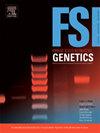Tramadol-related fatalities: Metabolic ratios & SNPs/INDELs belonging to UGT1A8, UGT2B7, ABCC2, and SLC22A1
IF 3.1
2区 医学
Q2 GENETICS & HEREDITY
引用次数: 0
Abstract
Genetic polymorphism can cause variation in tramadol (TR) pharmacokinetic characteristics and the expected clinical response. In forensic toxicology, the data about parent and metabolite concentrations (MRs; metabolic ratios) could facilitate to determine the cause of death and to assess time between drug intake and death. In this study, the aim was to investigate if UGT1A8, UGT2B7, ABCC2, and SLC22A1 genotyping can facilitate interpretation by investigating the frequency of UGT1A8, UGT2B7, ABCC2, and SLC22A1 genotypes in forensic autopsy cases positive for TR and to assess whether there is a correlation between these genetic variants and MRs. Cases positive for TR (n = 48) were genotyped by HaloPlex Target Enrichment system for UGT1A8, UGT2B7, ABCC2, and SLC22A1 sequencing, in order to identify single nucleotide polymorphisms (SNPs) and/or insertion deletion (INDELs). In addition to, the concentrations of TR and its metabolites (M1 & M2) were determined by LC-MS/MS. Cases were categorized by cause of death. The investigated SNPs/INDELs were not overrepresented in any group. We found significant correlations between several loci (12 out of 73) in UGT1A8, ABCC2, and SLC22A1 genes and MRs (M2/M1, TR/M2, and TR/M1) in post-mortem TR cases. These results indicate these polymorphisms in the 4 investigated genes might influence TR pharmacokinetics leading to an unsatisfactory therapeutic effect or increasing the risk of toxicity. However, these findings should be supported in future studies with larger groups of cases.
曲马多相关死亡:UGT1A8、UGT2B7、ABCC2和SLC22A1的代谢比率和snp / indel。
遗传多态性可引起曲马多(TR)药代动力学特征和预期临床反应的变化。在法医毒理学中,母体和代谢物浓度(MRs;代谢比率)有助于确定死亡原因和评估药物摄入与死亡之间的时间。本研究旨在通过调查法医尸检TR阳性病例中UGT1A8、UGT2B7、ABCC2和SLC22A1基因型的频率,探讨UGT1A8、UGT2B7、ABCC2和SLC22A1基因型是否有助于解释,并评估这些基因变异与mr .之间是否存在相关性。对TR阳性病例(n = 48)采用HaloPlex靶富集系统对UGT1A8、UGT2B7、ABCC2和SLC22A1进行测序分型。以鉴定单核苷酸多态性(snp)和/或插入缺失(INDELs)。此外,采用LC-MS/MS法测定了TR及其代谢产物(M1和M2)的浓度。病例按死因分类。所调查的snp / indel在任何组中都没有过度代表。我们发现UGT1A8、ABCC2和SLC22A1基因的几个位点(73个中的12个)与死后TR病例的MRs (M2/M1、TR/M2和TR/M1)之间存在显著相关性。这些结果表明,这4个基因的多态性可能会影响TR的药代动力学,导致治疗效果不理想或增加毒性风险。然而,这些发现应该在未来更大规模的病例研究中得到支持。
本文章由计算机程序翻译,如有差异,请以英文原文为准。
求助全文
约1分钟内获得全文
求助全文
来源期刊
CiteScore
7.50
自引率
32.30%
发文量
132
审稿时长
11.3 weeks
期刊介绍:
Forensic Science International: Genetics is the premier journal in the field of Forensic Genetics. This branch of Forensic Science can be defined as the application of genetics to human and non-human material (in the sense of a science with the purpose of studying inherited characteristics for the analysis of inter- and intra-specific variations in populations) for the resolution of legal conflicts.
The scope of the journal includes:
Forensic applications of human polymorphism.
Testing of paternity and other family relationships, immigration cases, typing of biological stains and tissues from criminal casework, identification of human remains by DNA testing methodologies.
Description of human polymorphisms of forensic interest, with special interest in DNA polymorphisms.
Autosomal DNA polymorphisms, mini- and microsatellites (or short tandem repeats, STRs), single nucleotide polymorphisms (SNPs), X and Y chromosome polymorphisms, mtDNA polymorphisms, and any other type of DNA variation with potential forensic applications.
Non-human DNA polymorphisms for crime scene investigation.
Population genetics of human polymorphisms of forensic interest.
Population data, especially from DNA polymorphisms of interest for the solution of forensic problems.
DNA typing methodologies and strategies.
Biostatistical methods in forensic genetics.
Evaluation of DNA evidence in forensic problems (such as paternity or immigration cases, criminal casework, identification), classical and new statistical approaches.
Standards in forensic genetics.
Recommendations of regulatory bodies concerning methods, markers, interpretation or strategies or proposals for procedural or technical standards.
Quality control.
Quality control and quality assurance strategies, proficiency testing for DNA typing methodologies.
Criminal DNA databases.
Technical, legal and statistical issues.
General ethical and legal issues related to forensic genetics.

 求助内容:
求助内容: 应助结果提醒方式:
应助结果提醒方式:


